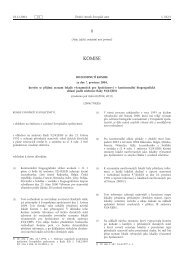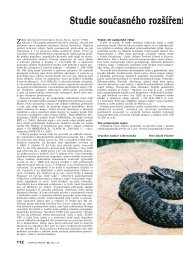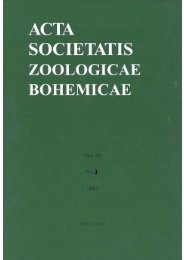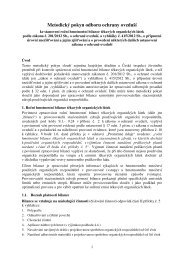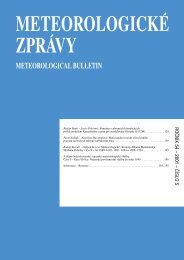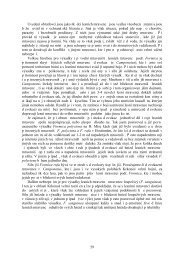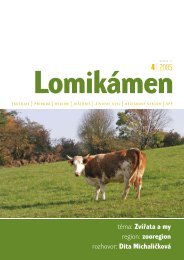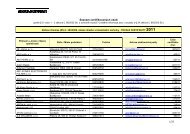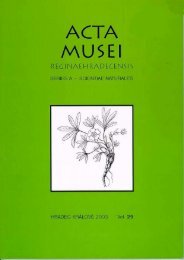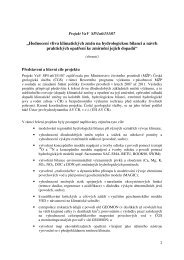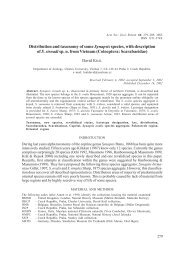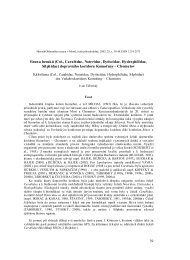journal of forest science
journal of forest science
journal of forest science
Create successful ePaper yourself
Turn your PDF publications into a flip-book with our unique Google optimized e-Paper software.
correlations that will arise between explanatory variables<br />
and error terms.<br />
METHODS<br />
PARAMETER ESTIMATES O SIMULTANEOUS<br />
SYSTEM O EQUATIONS<br />
To eliminate the bias and inconsistency <strong>of</strong> simultaneous<br />
equations (1)–(3), the two-stage least squares (2SLS)<br />
method, developed by Theil in 1953 and independently<br />
by Basmann in 1957 as referenced in KONTSOYIANNIS<br />
(1977), has been widely used in econometrics<br />
(JOHNSTON 1991) and in <strong>forest</strong> biometrics (BORDERS,<br />
BAILEY 1986; BORDERS 1989). In 2SLS, regression instruments<br />
(instrumental variables) are obtained in the first<br />
stage by employing OLS to estimate the reduced form<br />
equation. The series <strong>of</strong> predicted values <strong>of</strong> RHS endogenous<br />
variables are then generated as regression instruments.<br />
These instruments are used in the second stage <strong>of</strong><br />
estimation, where least squares procedures are employed<br />
to estimate the parameters <strong>of</strong> the structural equation by<br />
substituting the regression instruments for the RHS endogenous<br />
variables, when they appear as explanatory<br />
variables in a structural equation. These predicted RHS<br />
endogenous variables are uncorrelated with the error<br />
components <strong>of</strong> the LHS endogenous variables, and resulting<br />
parameter estimates are biased in small samples<br />
but consistent, and are asymptotically unbiased in large<br />
samples (KONTSOYIANNIS 1977).<br />
Three-stage least squares (3SLS) method extends twostage<br />
least squares (2SLS) by applying generalized least<br />
squares procedures in the estimation <strong>of</strong> structural equations.<br />
The variance-covariance weighting matrix used in<br />
the generalized least squares estimation is derived from<br />
the residuals obtained in the second stage <strong>of</strong> estimation<br />
in 2SLS. The 3SLS estimator takes into account the correlations<br />
<strong>of</strong> error terms across the equation, and makes<br />
use <strong>of</strong> the information that may be available concerning<br />
the variance-covariance matrix <strong>of</strong> the error terms across<br />
different structural equations. Resulting estimates <strong>of</strong> the<br />
parameters for the entire system from 3SLS are consistent<br />
and asymptotically more efficient than those obtained<br />
from 2SLS when the cross-equation correlations are significant.<br />
But when the cross-equation co-variances are<br />
all zero, 3SLS and 2SLS will yield identical estimates.<br />
Two problems frequently encountered in a simultaneously<br />
interdependent system <strong>of</strong> equations are the identification<br />
and the choice <strong>of</strong> instruments. Application <strong>of</strong><br />
simultaneous equation estimation techniques requires<br />
that each equation in a system <strong>of</strong> simultaneous equations<br />
must be exact- or over-identification (AMATEIS et al.<br />
1984; JUDGE et al. 1985; BORDERS, BAILEY 1986;<br />
JOHNSTON 1991). Identification requires that certain<br />
rank and order conditions be satisfied, that means the<br />
necessary conditions (order conditions) and the sufficient<br />
conditions (rank conditions) must be required to be satisfied.<br />
Criteria have been developed in order to make the<br />
identification <strong>of</strong> systems <strong>of</strong> equations possible for the simultaneous<br />
equations model that is linear in parameters<br />
and variables. It should be noted that non-linearity <strong>of</strong><br />
variables and parameters rather complicates the identification<br />
process (JUDGE et al. 1985; BORDERS, BAILEY<br />
1986). Also, the theory <strong>of</strong> fitting nonlinear systems <strong>of</strong><br />
related equations is not complete (BORDERS 1989). However,<br />
the problem is not serious enough. AMEMIYA<br />
(1988) pointed out that non-linearity generally helps rather<br />
than hampers identification. or example, the number<br />
<strong>of</strong> excluded endogenous variables in a given equation<br />
need not be greater than or equal to the number <strong>of</strong> parameters<br />
<strong>of</strong> the same equation in a non-linearity model.<br />
HAUSMAN (1988) also pointed out that, speaking somewhat<br />
loosely, the identification problem no longer exists<br />
in fitting the system <strong>of</strong> non-linearity equations. As discussed<br />
by REED (1986), Zellner estimation (i.e. SUR)<br />
and 3SLS can be extended to such systems. Each equation<br />
in the system <strong>of</strong> non-linearity equations (1)–(3) has<br />
over-identification according to the criteria set by<br />
AMEMIYA (1988).<br />
The problem <strong>of</strong> finding instrumental variables for simultaneous<br />
linear equations is relatively simple and<br />
straightforward, because in the linear case the instrumental<br />
variables arise from the reduced form equation. All<br />
the predetermined variables including the exogenous<br />
variables, the lagged exogenous variables, and the lagged<br />
endogenous variables for the entire system are chosen as<br />
instruments (JUDGE et al. 1985). inding a proper set <strong>of</strong><br />
instrumental variables in the systems <strong>of</strong> non-linearity simultaneous<br />
equations is a very difficult problem, and the<br />
theory for doing so is not complete either (JUDGE et al.<br />
1985; BORDERS 1989) because the crucial difference<br />
between the nonlinear and linear simultaneous equation<br />
specification is that the former is the absence <strong>of</strong> a reduced<br />
form specification which allows the additive separation<br />
<strong>of</strong> jointly endogenous variables into a function <strong>of</strong><br />
the predetermined variables and stochastic disturbances<br />
in the linear case. In the nonlinear case the reduced form<br />
specification has a complicated function that does not<br />
usually exist in convenient closed form (HAUSMAN<br />
1988). The most disturbing aspect <strong>of</strong> nonlinear simultaneous<br />
equation estimators is that they are not invariant<br />
with respect to the choice <strong>of</strong> instruments. Different sets<br />
<strong>of</strong> instrument variables can lead to quite different parameter<br />
estimates even though the model specification and<br />
data remain the same. But no best choice <strong>of</strong> instruments<br />
exists (HAUSMAN 1988). In general, it is necessary that<br />
the number <strong>of</strong> selected instrument variables shall be at<br />
least equal to the number <strong>of</strong> regression parameters to be<br />
estimated in order to maximize the efficiency <strong>of</strong> instrumental<br />
variables and to reduce the simultaneous equation<br />
bias.<br />
The system <strong>of</strong> equations (1)–(3) estimated in this study<br />
and other examples presented in <strong>forest</strong>ry literature<br />
(AMATEIS et al. 1984; BORDERS 1989) have a clear resemblance<br />
to a special case <strong>of</strong> simultaneous equations<br />
discussed in Classification <strong>of</strong> equation systems section.<br />
288 J. FOR. SCI., 47, 2001 (7): 285–293



